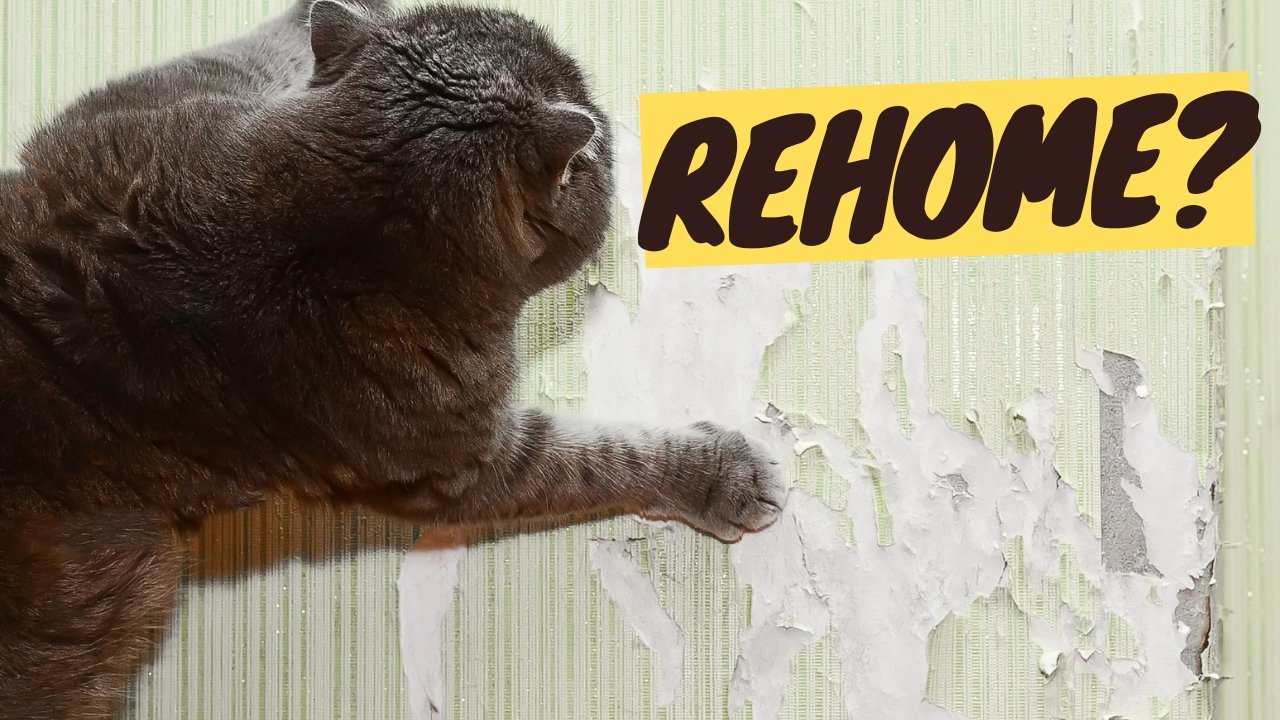As an Amazon Associate I earn from qualifying purchases.
Rehoming a cat can be emotional and complex. It requires careful planning and compassion.
Ensuring your cat finds a loving new home is vital for its well-being. Rehoming a cat is not a decision to take lightly. Many factors come into play, such as the cat’s age, health, and temperament. Understanding these will help you find the best match for your furry friend.
This guide will walk you through the necessary steps to ensure a smooth transition. From evaluating potential homes to preparing your cat for the move, we cover all the essential details. By following these steps, you can make the rehoming process as stress-free as possible for both you and your beloved pet.

Credit: www.seattleareafelinerescue.org
Preparing For Rehoming
Rehoming a cat is a big decision that requires careful planning. To ensure a smooth transition, it is essential to prepare adequately. This section will guide you through the necessary steps to get ready for rehoming your feline friend.
Assessing The Decision
Before you proceed, assess if rehoming is the best option for your cat. Consider the following:
- Is the cat experiencing stress in its current environment?
- Are there significant changes in your life that affect your ability to care for the cat?
- Have you exhausted all other options to keep the cat?
Make sure to discuss with family members or a veterinarian to understand if rehoming is the right choice.
Gathering Important Documents
Having all necessary documents ready will ease the rehoming process. Ensure you have:
- Medical Records: Vaccination history, past illnesses, and treatments.
- Adoption Papers: Proof of ownership, if applicable.
- Behavioral Notes: Any quirks or habits the cat has.
Keep these documents organized and ready to share with the new owner. It helps them understand the cat’s history and needs.
| Document | Details |
|---|---|
| Medical Records | Include vaccination history and treatments. |
| Adoption Papers | Proof of ownership. |
| Behavioral Notes | Any quirks or habits. |
Preparing for rehoming is crucial for your cat’s well-being. Follow these steps to ensure a smooth transition.
Finding The Right New Home
Rehoming a cat is a delicate process. It’s important to find the right new home where your cat will be loved and well cared for. This section will guide you through the key steps in finding the perfect match for your feline friend.
Creating A Pet Profile
Start by creating a detailed pet profile for your cat. This helps potential adopters understand your cat’s needs and personality.
- Basic Information: Name, age, breed, and gender.
- Health: Vaccination status, any medical conditions, and recent vet visits.
- Behavior: Is your cat friendly, shy, or playful?
- Habits: Litter box trained, scratching habits, and favorite toys.
Include clear photos of your cat. Make sure the photos show your cat in a good light. A smiling, relaxed cat will attract more interest.
Reaching Out To Potential Adopters
Once the pet profile is ready, it’s time to reach out to potential adopters. Use various platforms to spread the word.
- Social Media: Post on Facebook, Instagram, and Twitter. Use local pet rehoming groups.
- Online Listings: Websites like Petfinder and Adopt-a-Pet.
- Local Ads: Community boards, local newspapers, and vet offices.
When you receive inquiries, ask questions to understand if the adopter is a good fit. Here are some questions to consider:
- Do you have other pets?
- What is your experience with cats?
- Do you have a plan for veterinary care?
- Is your home environment suitable for a cat?
Arrange a meet-and-greet. This helps you see how your cat interacts with the potential adopter. Trust your instincts and ensure your cat’s new home will be a safe and loving environment.
Screening Potential Adopters
Ensuring your cat goes to a loving home is vital. Screening potential adopters can help you find the best match. Here are key steps to follow:
Conducting Interviews
Start by conducting interviews with potential adopters. Ask questions about their past experiences with pets. This helps you understand their level of commitment.
Use these questions as a guide:
- Have you had pets before?
- What happened to your previous pets?
- Why do you want to adopt a cat?
- Who will be responsible for the cat’s care?
- Do you have other pets currently?
These questions will give you insight into their readiness and suitability. Take notes during the interview for later review.
Home Visits
After a successful interview, schedule a home visit. This step is crucial to ensure the environment is safe and suitable.
During the visit, check for:
- Secure doors and windows
- Availability of food and water bowls
- Safe sleeping areas
- Any hazards like exposed wires or toxic plants
Use a checklist to stay organized:
| Items to Check | Status |
|---|---|
| Secure doors and windows | |
| Availability of food and water bowls | |
| Safe sleeping areas | |
| Any hazards |
A thorough home visit will ensure the cat’s future well-being. If everything checks out, the adopter is likely a good fit.
Introducing Your Cat
Introducing your cat to a new home can be a challenging process. It’s important to ensure a smooth transition for both your cat and any existing pets. Taking the right steps can help your cat feel more comfortable and secure in their new environment.
Meeting In A Neutral Space
Start by introducing your cat in a neutral space. A room that neither your new cat nor your resident pets frequent often is ideal. This helps reduce territorial behavior. Allow both cats to explore this new space. This will help them get used to each other’s scent.
Keep the initial meetings short. Monitor their reactions closely. If they seem stressed, separate them and try again later. Gradually increase the duration of these meetings as they become more comfortable with each other.
Supervised Visits
Once your cats are familiar with each other’s scent, you can start supervised visits. Keep these sessions brief at first. Use a baby gate or a screen door to create a physical barrier. This allows them to see and smell each other without direct contact.
Stay calm and offer treats to encourage positive associations. If any aggressive behavior occurs, separate them immediately. Gradually increase the time they spend together as their comfort levels improve.
Remember, patience is key. Every cat adjusts at their own pace. With time and care, your cats will learn to coexist peacefully.
Transitioning To The New Home
Transitioning your cat to a new home can be a delicate process. Cats are creatures of habit. A change in environment can be stressful. With proper planning, you can make the transition smooth. This guide will help you understand the essentials for packing and tips for the first day in the new home.
Packing Essentials
Before moving, gather all the necessary items for your cat. This will ensure that your cat feels comfortable and secure in the new home.
| Item | Purpose |
|---|---|
| Carrier | Safe transportation |
| Food and Water Bowls | Maintain regular feeding |
| Favorite Toys | Provide comfort |
| Bed or Blanket | Familiar scent |
| Litter Box | Maintain hygiene |
First Day Tips
The first day in the new home is crucial. It sets the tone for how your cat will adapt.
- Set up a safe room: Choose a quiet room for your cat. Place the litter box, food, and water bowls here.
- Allow exploration: Let your cat explore the room. Keep other areas off-limits initially.
- Maintain routine: Stick to the feeding and playtime schedule. This provides a sense of normalcy.
- Provide comfort: Use familiar items like the cat’s bed or favorite toys. These items carry a comforting scent.
- Monitor behavior: Watch for signs of stress. Extra hiding or reduced appetite can indicate anxiety.
Remember, patience is key. Each cat adapts at its own pace. Offer plenty of love and reassurance.

Credit: www.reddit.com
Supporting The New Family
Rehoming a cat involves more than just finding a new place for it to live. Ensuring the new family feels supported and confident is key. This helps the cat settle in smoothly and ensures the new owners feel prepared. Here are some ways to support the new family during this transition.
Providing Background Information
Share all important details about the cat. This includes its age, health history, and vaccination records. Knowing the cat’s dietary preferences and any special needs can help the new owners care for it properly.
| Information | Details |
|---|---|
| Age | 3 years |
| Health History | Up-to-date vaccinations, no known illnesses |
| Diet | Grain-free dry food, occasional wet food |
Provide information about the cat’s behavior and personality. Is it playful, shy, or independent? These details help the new family understand what to expect.
Offering Ongoing Advice
Stay available for questions after the cat moves. Offer tips on settling the cat into its new home. Share advice on creating a safe and comfortable space for the cat.
- Provide a quiet room for the first few days
- Introduce the cat to other pets gradually
- Maintain a consistent feeding schedule
Encourage the new family to reach out if they face challenges. Offer suggestions on managing common issues like litter box training or scratching. This ongoing support builds confidence and ensures a smoother transition.
Handling Emotional Aspects
Rehoming a cat involves handling the emotional aspects carefully. Focus on ensuring the cat feels secure and loved during the transition. Communicate openly with the new owner to ease the process for everyone involved.
Rehoming a cat is a tough decision. It impacts both you and your pet. Emotions can run high during this period. Understanding and managing these feelings is important.Coping With Guilt
Feeling guilty is natural. You may worry about your cat’s future. Remember, finding a loving home is your goal. Think about why rehoming is necessary. Focus on the benefits for your cat. Talk to friends or family about your feelings. They can offer support. Sharing your thoughts helps reduce guilt. You are not alone in this situation.Staying Connected
Consider staying in touch with the new owner. This can ease your mind. Ask for updates and photos. Knowing your cat is happy helps with the transition. You can also visit your cat if the new owner agrees. Regular visits can bring comfort. It ensures your cat is well cared for. Maintaining a connection helps both you and your pet. It makes the rehoming process smoother. “`Legal Considerations
Rehoming a cat involves more than just finding a new home. Understanding the legal aspects is crucial. This ensures a smooth transition for the cat and peace of mind for both parties.
Transfer Of Ownership
When rehoming a cat, a transfer of ownership document is essential. This document serves as proof that the cat’s ownership has changed. It should include:
- The new owner’s name and contact details
- The cat’s name, age, and identifying features
- The date of transfer
Both parties should sign the document. Keep a copy for your records. This helps in case of future disputes.
Adoption Agreements
An adoption agreement outlines the terms under which the cat is being rehomed. This agreement should cover:
- Health and medical history of the cat
- Any special care or dietary requirements
- Return policy if the new owner can no longer care for the cat
Having a detailed adoption agreement protects both the cat and the new owner. It ensures clear expectations from the start.
| Document | Purpose |
|---|---|
| Transfer of Ownership | Proof of change in ownership |
| Adoption Agreement | Terms and conditions of adoption |
Being aware of these legal considerations can make the rehoming process smoother. It ensures the well-being of the cat and satisfaction for the new owner.

Credit: www.outdoorbengal.com
Frequently Asked Questions
How Do I Prepare My Cat For Rehoming?
Start by ensuring your cat is healthy. Gather medical records and favorite items. Gradually introduce your cat to the new environment.
What Should I Include In My Cat’s Rehoming Profile?
Include your cat’s age, breed, health status, and personality traits. Add clear, recent photos and any special needs.
How Can I Find A Good New Home For My Cat?
Reach out to friends, family, and local shelters. Use social media and adoption websites to find potential adopters.
What Should I Ask Potential Adopters?
Ask about their experience with cats, living situation, and other pets. Ensure they understand the responsibility of pet ownership.
Conclusion
Rehoming a cat is a big responsibility. Always consider the cat’s needs first. Find a loving, stable home. This ensures a smooth transition. Talk to potential adopters. Ask questions about their experience with pets. Visit their home, if possible. Stay involved in the process.
This helps ensure the best fit. Your cat deserves a happy, safe future. Thank you for making thoughtful decisions. The well-being of your cat depends on it.
As an Amazon Associate, I earn from qualifying purchases.


